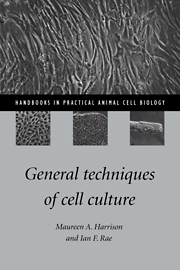1 - Introduction
Published online by Cambridge University Press: 02 February 2010
Summary
The aim of this volume is to provide a guide to the basic essentials of tissue culture, progressing from the equipment needed, through useful media and sera to the handling of different types of cells, their growth and storage, how to recognize and deal with contamination, and to provide some pointers towards good quality control and safe handling procedures. Detailed protocols on specialized applications are outside the scope of this book, although a chapter is included which covers the basics of some of the more widely used special techniques.
Individual volumes in this series deal with the specific cultures of primary cell types, but before commencing on a project necessitating more specialized skills it may be useful to experience the pleasures and pitfalls of basic tissue culture methods, which will be applicable to primary systems, through handling cell lines. Cell banks and smaller cell production facilities exist largely for the purpose of issuing cell lines and during the culturing of a few selected varieties, anyone of average dexterity and with a good grasp of sterile technique will soon develop a basic expertise.
Tissue culture developed from some of the embryology techniques used in the last century, which involved maintaining the medullary plate of a chick embryo in warm saline. Attempts were also made to maintain pieces of human skin in vitro. This was followed by attempts to maintain leukocytes from the salamander in hanging droplets (Jolly, 1903). From this early work, the traditional tissue culture techniques were rapidly devised. The term ‘tissue culture’ includes both cell and organ culture, although within the confines of this book we will be discussing only the former.
- Type
- Chapter
- Information
- General Techniques of Cell Culture , pp. 1 - 6Publisher: Cambridge University PressPrint publication year: 1997
- 3
- Cited by

